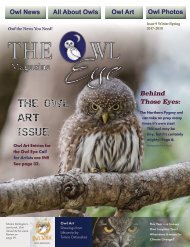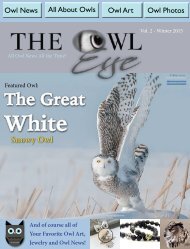owl_eye_issue4_online
You also want an ePaper? Increase the reach of your titles
YUMPU automatically turns print PDFs into web optimized ePapers that Google loves.
Owl the News that fit to Print!<br />
Mitchell Pruitt, center, holds up a captured Saw-whet for<br />
onlookers to view as he records banding data<br />
“In fall of 2014, we started research capturing and banding the pint-sized<br />
Northern Saw-whet Owl in Arkansas.<br />
This elusive bird of prey spends its summers in northern forests and has been discovered to be migratory in fall throughout<br />
most of North America. Little work has been done in the south, in fact the species was known only from 12 records in<br />
Arkansas prior to our research and was thought to be a rare fall/winter visitor to the state. With a late start, we only captured<br />
two birds during our 2014 season, but for a species that hadn't been detected in Arkansas since 2010, that was pretty exciting.<br />
We started our second field season in October 2016 and captured 22 individuals, with up to 10 others detected vocally.<br />
Two birds were foreign recaptures, one banded at Stevens Point, Wisconsin in October 2013 and another banded in Duluth,<br />
Minnesota in September 2015!<br />
To capture this tiny <strong>owl</strong>, we set up four, 12-meter mist nets in a line and have a caller in the center of the arrangement<br />
broadcasting different vocalizations of the species. Birds in the area or migrating through will become curious and stop to<br />
check it out, hopefully getting caught in the process. Each saw-whet is banded, weighed, measured, aged, sexed, and released.<br />
In doing this research, we hope to get an idea for how many migrate through our area and when, as well as simply show that<br />
they are, in fact, migrating through. Despite there being many research stations working with the species in Canada and the<br />
northern United States, its movements remain largely a mystery, which is why our research in Arkansas is so important. Based<br />
on our work in Arkansas and studies in northern Missouri, it would appear that we are in a previously unknown migratory<br />
pathway.”<br />
35












